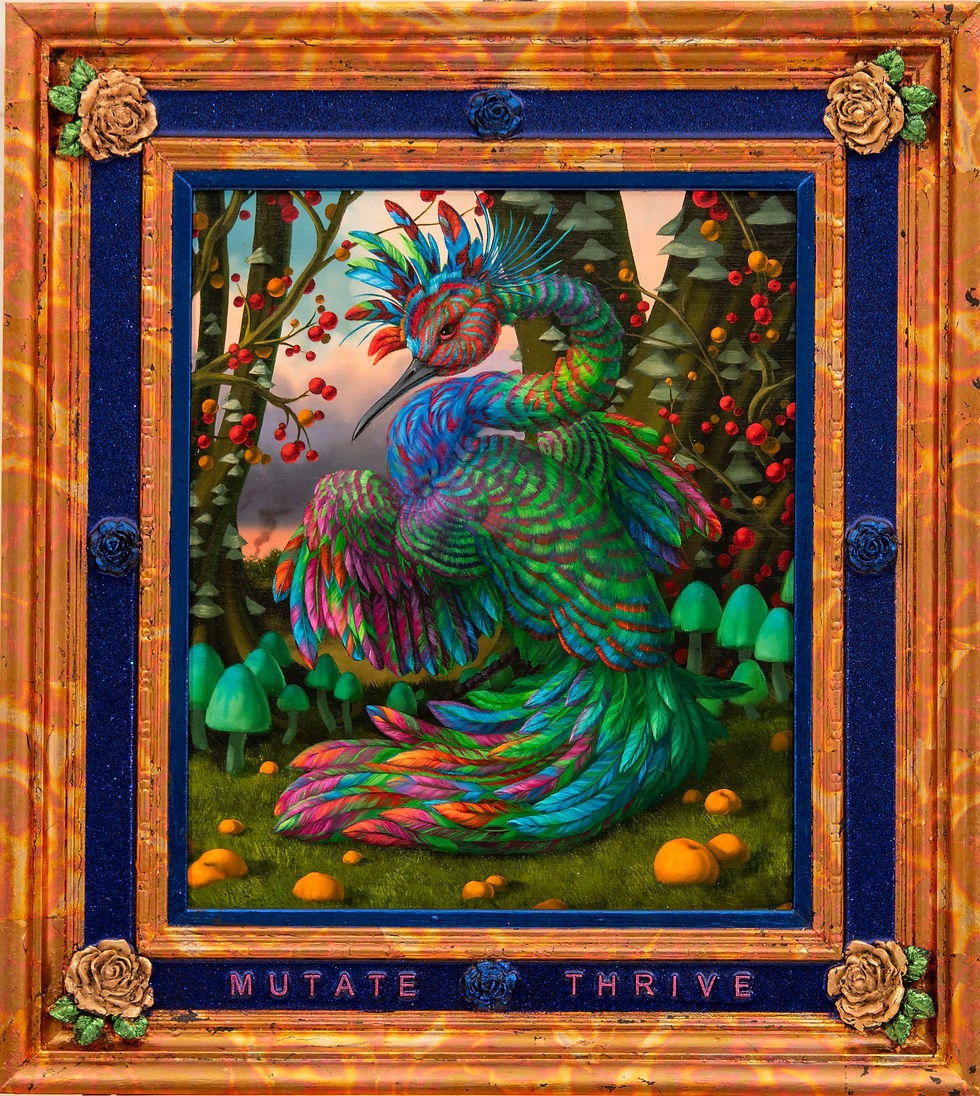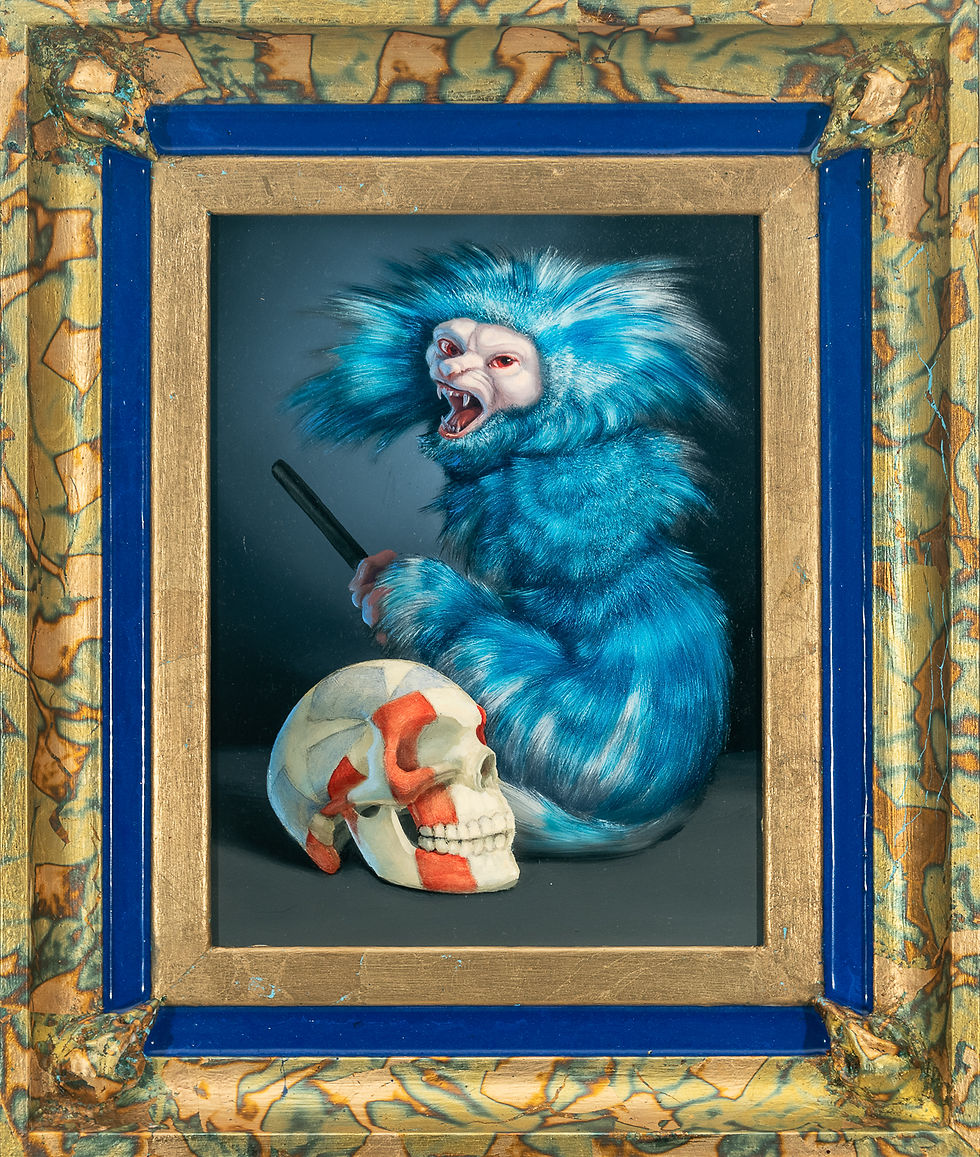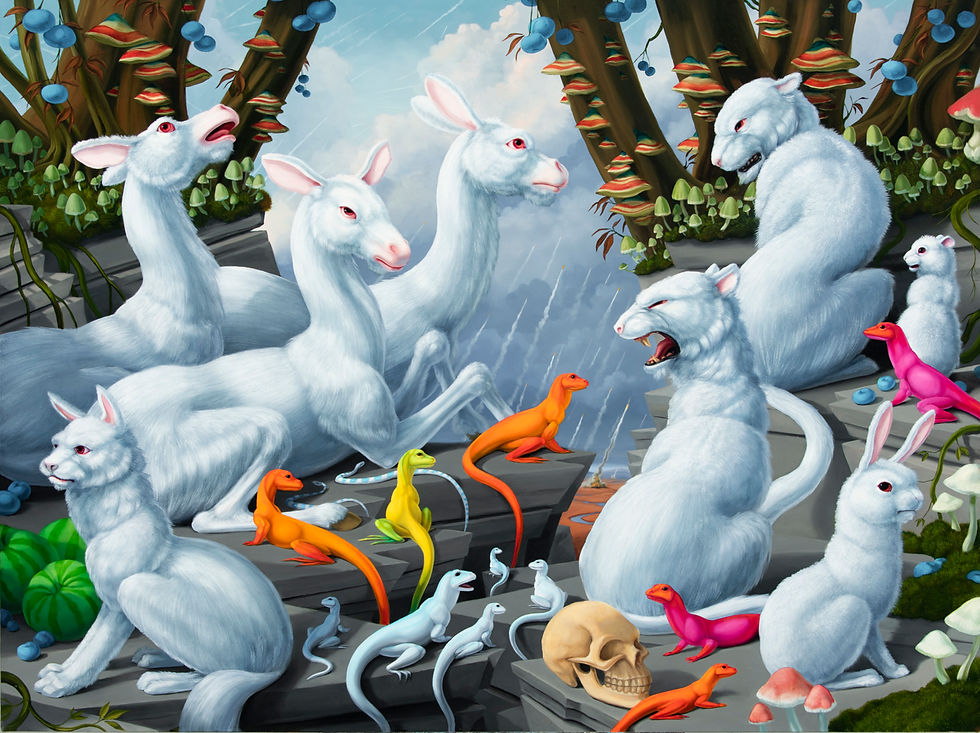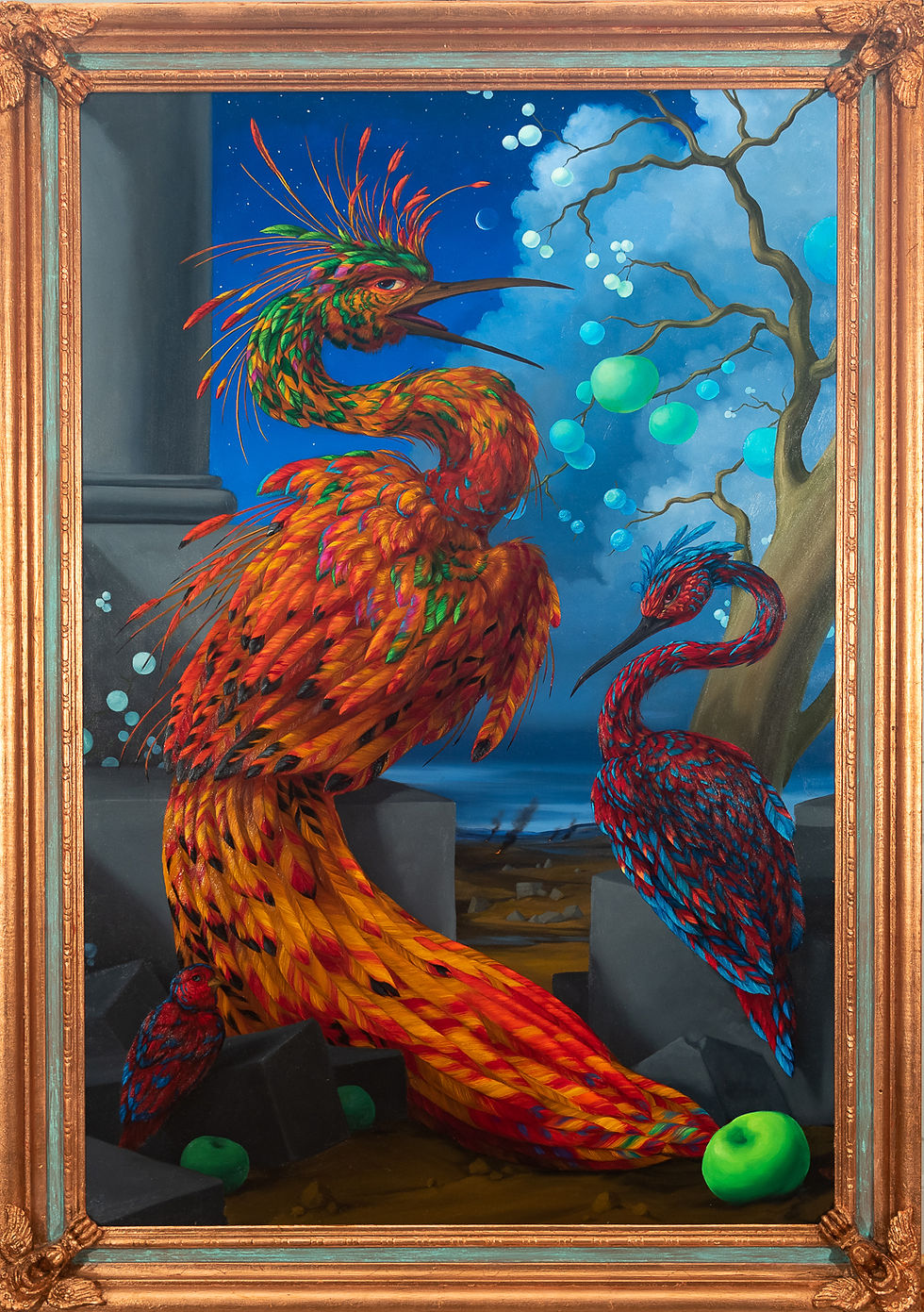Interview with Artist Laurie Hogin
- September Herrin
- Jul 17
- 10 min read
We first encountered Laurie Hogin’s art while en route to LA for the AWP Conference earlier this year. Her work caught our attention from across a chaotic concourse at the SeaTac Airport and we’ve been captivated ever since. Laurie’s use of brilliant colors and compelling narrative invites us to explore a world where adaptability and mutation are key to survival. We caught up with Laurie for a fascinating interview below.
What do you hope readers gain from experiencing your work?
I hope the work makes viewers want to look closely, to enjoy the detail, the color, and the human origin evident in the technique. I want to make the time they spend worthwhile by offering visual pleasure, humor, and strangeness that has enough of the familiar that it can echo in their memories
and through their senses—that it offers them something relatable. And of course, I hope it invites them to consider the ideas that the works present. I hope they enjoy the conceptual aspects of the work, including the literary and critical strategies, the parody and comedy, the sense of longing and kinship, the sensory and emotional content, and the occasional political or editorial cartooning.

The other major theme in many of these works is, essentially, that all kinds of variation and multiplicity, all kinds of strange differences, biological, political, and creative, are necessary for evolution, and that the weirdness, oddness, and uniqueness of random mutation or change is necessary to evolution. Diversity of thought, of feeling, of being, will abide and resist; no amount of imposed conformity can eliminate it, whether in monocultural soybean fields or in human society, and we must protect and defend the systems, natural and political (specifically, wild ecosystems and liberal democracies) that permit and support it.
What makes you keep painting, even when it's hard?
Obligations to myself to make work that represents the best of my thinking and abilities while I am still alive and able; obligations to others—like my students—to whom I owe ongoing refinement of my understanding and expertise; to my gallery, curatorial, and editorial partners who take risks and devote labor to place my work in productive cultural ecosystems; collectors who buy my work and so enable me to continue making it, because I’m lucky to have them! Also, I need a lot of solitude and painting is a way to be alone without feeling like I’m being idle.
Advice on creating that you’ve learned by trial and error?
Pay attention to everything that gets your attention; absorb assiduously, and, where appropriate, study and research. Be open to and in fact seek out other ways of seeing and thinking about the world. Make notes so you don’t forget, and work as hard as you can without sacrificing other important things. When creative work goes badly, decide whether it’s best to wrestle the beast into submission immediately, or to study, research, ponder, and gather more—or lock it down, walk away, and attend to something else for a while. Then follow through on your choice. If these things fail, have something caffeinated.
What are your long-term artistic goals?
Like all artists, I’m trying to make the work that’ll make me feel like I don’t need to make any more work. Achieving this goal is highly uncertain, and the consequences of achieving it are even more so.
Is there a book or film that significantly altered your perception of reality?
In 1973, George Clinton’s band Funkadelic made a music video for the song "Cosmic Slop." Its New York setting included locations that were recognizable and evocative to me because of the state of the city in the 1970s—chaotic and abandoned by good government and the site of a counter-culture that over the previous decade had realized both great liberatory gains for many marginalized groups but also devastating, pathological consequences for the most vulnerable. I saw it when I was probably

about 14, on late-night television, around 1978. Most, but not all, of the performers in the video were Black. They were dressed in what might be described as apocalyptic tribal monster costumes. The choreography telegraphed both aggression and community, anger and love, marginalization and assertion. The performance struck me as embodying pain, protest, and possibility all at once. I was politically pretty aware by that age, including some small degree of awareness about the fraught and tragic nature of racial politics and history, and of course Black music was a huge part of my world, even as a suburban teen. This performance moved me to new understandings of what art could mean and what storytelling and metaphor could do to represent political and social experience, change culture, and maybe influence the world. Along with the other Black arts in my world—especially Soul Train and WBAI radio—I began to understand the work of Black artists in a whole new way. I began to see Black and multiracial spaces (as we would describe it now) where Black artistic voices were foreground as drivers of any cultural, and therefore political progress we could make as a nation. I still think it’s powerful and I show it to students as an example of the liberatory uses of artistic monstrosity. Here’s a link to the video.
Do you paint every day, as the mood hits you, or do you have a rigid schedule?
I try to get some creative work done every day, but of course I have other obligations, too. Efficiency is key, especially when working under a deadline. Fortunately, a great deal of creative work can be done while exercising. A warm brain is an active brain; squirmy and fecund.
Where do you go when you need to work out a creative block?
I go to the woods! To the WOODS!!
If you were a cryptid, what would your name be and what strange habits would people whisper about?

Lesser Eastern Magenta Mad Bunny (lepus iratus purpurea). This reclusive creature, characterized by its brightly colored, patterned fur, unusual canid dentation, and human-like eyes, lives in small family groups that often include nonrelative and multispecies individuals whose pelts, feathers, or skins are similarly garishly colored. They are mostly plant-eaters, preferring chili peppers, broccoli, and sweet clover blossoms, but will occasionally hunt insects and small crustaceans. They will also eat pastries, if available. Possessed of an unusually robust, highly acidic digestive system, similar to that of carrion birds, they will also eat any literature they may find, including books, newspapers, and magazines across the ideological and political spectrum. This unusually varied diet results in some strange shit. They live in complex burrows, which they constantly adjust in response to a dynamic environment. They will defend them fiercely if threatened, often confronting intruders much larger than they are, especially if those intruders display superior airs or elitist attitudes and are not particularly bright, but they will also happily accommodate novel species with completely different
opinions as long as those opinions are driven by similar values. Their more unusual behaviors include tree climbing for the purpose of socializing with ravens, owls, and bark beetles, and for pointless athletic contests.
What's your favorite obscure novel or short story (a work you never hear anyone else talking about)?
Most of what I read is nonfiction—history, science, politics, economics, philosophy. However, when I was a child, one of my favorite books was The Wonderful Flight to the Mushroom Planet by Eleanor Cameron, a children’s sci-fi adventure published in 1954. It’s about the good things that come from scientific curiosity, intuition, and generosity all in combination. The story is set on a luminescent, mossy little planet covered in giant mushrooms and inhabited by a race of child-sized humanoids who were suffering an ecological disaster. This planet sounded like a refuge to me—close enough to Earth to visit in a homemade rocket but obscured by blue-green mists to all but sufficiently curious and faithful children. I don’t know anyone else who’s familiar with it, but perhaps it's like the planet it describes—close but hidden in its smallness and humble beauty.

Have you ever had a supernatural encounter?
I’m not sure.
When I was 11, our family had to move somewhat suddenly because our house was too small for all of us plus my brother, who was coming home after living for many years in a residential facility for developmentally disabled, autistic children. This was in 1974, when theories about autism were positively benighted. Unable to find a suitable new house for the long term, my parents moved us into a derelict mansion, which we would fix up enough to make habitable for us and sellable for the owners by the end of our occupancy. The house had nearly sixty rooms; some were Addams Family, some were Munsters, and some were more Tales from the Crypt. It had overgrown gardens full of gnarled rhododendrons that resembled bony limbs under their dark leaves. There were towering, unkempt, fungus-riddled trees edging a grim ravine. The cascading gardens were surrounded by high, ivy-covered stone walls; the furthest, deeply sunken and hiding an ornate gazebo in near-total collapse. The house had a coal room, stables, and a livery yard. It had secret rooms, because that was a thing when it was built. It was full of ghostly things like boxes of Gilded Age clothing, which we dusted off and tried on, and house plans, with strange notations that turned out to locate hidden storage compartments. What these nooks once contained, we could only guess. Off the far side of the cavernous white tile kitchen was the servants’ hall, six bedrooms arranged along a corridor with a larger room at the end. Perhaps that was the butler’s room. That section of the house looked as though a hurricane had torn through it; broken windows, shattered plaster, upturned furniture. On occasional nights through the deep part of the summer, I could hear the doors in that hall slam, mostly randomly, but once, clearly in sequence, up one side and down the other. I wasn’t the only one. One morning, our father angrily accused our brother of waking him with the door-slamming. My brother denied this in the blunt and completely truthful way of an autistic person. Next Dad accused me, as I was a night owl, even as a child, which is why I was awake to hear it, but I was not the culprit. Nor were either of my sisters, who slept soundly throughout. Summer nights do bring thunderstorms and strong night
winds, and architecture can act as a baffle with unpredictable results. That’s all I know.
If you could travel anywhere in the universe, where would it be?
Since one of the major theoretical descriptions of the universe understands it as spacetime, I would choose any number of destinations along that continuum so that I’d be able to travel through time. There’d have to be a lot of preconditions, though. For example, my current brain structure would have to remain constant—no regression or senescence—and my presence in different locations in spacetime would not alter future events, because I might inadvertently do something that’d have undesirable results. And I’d have to be invulnerable to physical trauma and pathogens and properly equipped for destinations as varied as the Carboniferous on Earth, some gorgeous exoplanet, or my grandmother’s house when her roses were in bloom (that one wouldn’t really require any special equipment).

What’s the one mystery of the human condition you wish could be solved?
The need for pride, power, and prestige at the expense of empathy, goodness, and fairness. It’s probably not so mysterious, given what was set in motion when the primordial ocean rendered forth a self-replicating molecule. But we sure would be better off if it didn’t find such extreme expression in certain individuals.
Did you have a favorite game of make-believe as a kid? How about now?
I pretended to live in the woods as either a wild animal with a human-like consciousness or as a human in animal form. I no longer pretend but rather engage with the fantasy as a form of philosophical conjecture and as a starting point for my narrative images.
How do you cope with existential dread? How about existential joy?
In the case of dread, I do something that needs to be done—and so much needs to be done—like feeding people or fixing something. In the case of existential joy, I think Emily Dickinson offers some helpful how-to in her poem, “Because I Would Not Stop for Death.” I take it as a suggestion to pay attention to the feeling of being, and of noticing, a momentary and unique expression of an unfathomably complex, tangled, rhizomatic cosmos. Other examples might include a megalodon shark, a fern, a star, an argon atom, a mushroom, or an interaction with an infant. Also, the very existence of the poem, and of art generally, suggests that it is really important to make a record of the feeling. Such records can be stored and used as a studio or writing desk ingredient. In short, I pay deep attention, try to memorize the moment, and do my best to report my observations.
Do you have a favorite weirdo? (Could be famous, obscure, fictional, or a personal connection.)
I’m sure you mean “weirdo” in the best possible sense—the sense in which anyone engaged in weird art happily qualifies. You, me, everyone who reads or writes for, or contributes to, this magazine :D. The brilliant Emil Ferris, author of the stunning graphic novel, My Favorite Thing is Monsters comes immediately to mind.

Tell us a secret.
I lost most of my secrets many years ago. Some of them are still vaguely audible but garbled with
vibrato, like echoes from another level in a monumental subterranean structure such as a subway or parking garage for an extinct race of giants. The remainder—the ones I know the locations of—are all underground, some in soil that’s rough and dry and not very fertile. As a result, they are hard and shriveled, resembling ancient potatoes. Others are so deep in red and black clays that they simply can’t be retrieved. These clays are toxic, too, so the secrets will never grow. This is a condition I wish upon all my beloved young people, in due course.
How is a raven like a writing desk?
It has an inky, fathomless eye that can see into your soul when you get close enough to get its attention.
If you could purchase one item from David Lynch’s personal collection, which was recently on auction, what would it be?
The baby from Eraserhead. It activates my overactive maternal tendencies and it would look great in my studio, like a collectible doll from the underworld.
What is your favorite museum or gallery?
If I only get to pick one, I’ll pick the Metropolitan Museum of Art, in New York.
Unpopular opinion, go:
Some MFA programs are becoming corrupt.
Laurie Hogin is an artist and occasional writer who lives in rural Illinois with her husband and some weird animals. She received her BFA from Cornell University in 1985, where she also studied cultural anthropology, and her MFA from The School of the Art Institute of Chicago in 1989. Her work has been exhibited nationally and internationally for more than 35 years, is included in numerous public and private collections, and has been reviewed and reproduced in hundreds of publications. She’s been a professor of Studio Art at the University of Illinois, Urbana-Champaign since 1997.

